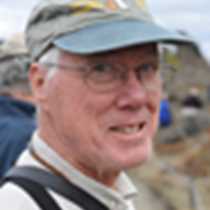Seno de las Montañas, the Chilean Fjords
It is called a temperate rain forest for good reason! In the Temperate Zone, the prevailing westerly winds pass over a relatively warm ocean, picking up a load of water vapor. When the moist winds strike the west side of a continent, the air is deflected upward, cools, and drops its moisture as precipitation. The result: a temperate rainforest. Were we at comparable latitude in North America, we would be at the northern tip of Vancouver Island, one of the dampest areas of that continent. Here in southern Chile the coastline is indented with myriad long, narrow fjords. As the glaciers of the Ice Ages waxed and waned, these valleys were repeatedly filled with glacial ice, each advance of the ice carving away more of the underlying rock to produce the magnificent scenery that we now enjoy. The lower slopes are covered with Southern Beech forest, but at this latitude, the tree line is close to the sea and the upper slopes show a mantle of tundra-like shrubs, moss, and lichens. And above that, we find a zone of perpetual snow and ice. Many of the fjords end with a glacial face at sea level (a tide-water glacier), the end of an icy journey that began with snowfall in the mountains above, or perhaps on the great Patagonian Ice Sheet. Other masses of ice spill over the steep slopes as hanging glaciers. Waterfalls and cascades descend spectacularly, fueled by the melting of ice and snow and by the late-summer rains.
Our afternoon Zodiac cruises in Seno de las Montañas gave us close looks at ice and forest, the blue and white of the ice contrasting with the greens of the forest highlighted by splashes of color of late-season flowering plants. One of the brightest was the stunning Fuschia magellanica seen above, adorning the forest margins. It is one of the few plants of this region to make it into our gardens at home. The cruise was capped by close-up views of immense Andean condors.
It is called a temperate rain forest for good reason! In the Temperate Zone, the prevailing westerly winds pass over a relatively warm ocean, picking up a load of water vapor. When the moist winds strike the west side of a continent, the air is deflected upward, cools, and drops its moisture as precipitation. The result: a temperate rainforest. Were we at comparable latitude in North America, we would be at the northern tip of Vancouver Island, one of the dampest areas of that continent. Here in southern Chile the coastline is indented with myriad long, narrow fjords. As the glaciers of the Ice Ages waxed and waned, these valleys were repeatedly filled with glacial ice, each advance of the ice carving away more of the underlying rock to produce the magnificent scenery that we now enjoy. The lower slopes are covered with Southern Beech forest, but at this latitude, the tree line is close to the sea and the upper slopes show a mantle of tundra-like shrubs, moss, and lichens. And above that, we find a zone of perpetual snow and ice. Many of the fjords end with a glacial face at sea level (a tide-water glacier), the end of an icy journey that began with snowfall in the mountains above, or perhaps on the great Patagonian Ice Sheet. Other masses of ice spill over the steep slopes as hanging glaciers. Waterfalls and cascades descend spectacularly, fueled by the melting of ice and snow and by the late-summer rains.
Our afternoon Zodiac cruises in Seno de las Montañas gave us close looks at ice and forest, the blue and white of the ice contrasting with the greens of the forest highlighted by splashes of color of late-season flowering plants. One of the brightest was the stunning Fuschia magellanica seen above, adorning the forest margins. It is one of the few plants of this region to make it into our gardens at home. The cruise was capped by close-up views of immense Andean condors.




